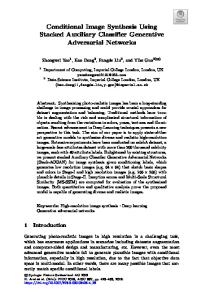HybridGAN: hybrid generative adversarial networks for MR image synthesis
- PDF / 1,564,266 Bytes
- 17 Pages / 439.37 x 666.142 pts Page_size
- 99 Downloads / 338 Views
HybridGAN: hybrid generative adversarial networks for MR image synthesis Jia Chen 1,2 & Shuang Luo 1 & Mingfu Xiong 1 & Tao Peng 1 & Ping Zhu 1 & Minghua Jiang 1 & Xiao Qin 3 Received: 25 July 2019 / Revised: 8 June 2020 / Accepted: 21 July 2020 # Springer Science+Business Media, LLC, part of Springer Nature 2020
Abstract
In this paper, we propose HybridGAN – a new medical MR image synthesis methods via generative adversarial learning. Specifically, our synthesizer generates MRI data in a sequential manner: first in order to improve the robustness of image synthesis, an input full-size real MR image is divided into an array of sub-images. Then, to avoid overfitting limited MRI encodings, these sub-images and an unlimited amount of random latent noise vectors become the input of automatic encoder for learning the marginal image distributions of real images. Finally, pseudo patches with constrained noise vectors are put into RU-NET which is a component of our HybridGAN to generate a large number of synthetic MR images. In RU-NET, A SpliceLayer is then employed to fuse sub-images together in an interlaced manner into a full-size image. The experimental results show that HybridGAN can effectively synthesize a large variety of MR images and display a good visual quality. Compared to the state-of-the-art synthesis methods, our method achieves a significant improvement in terms of both visual and quantitative evaluation metrics. Keywords Generative models . Generative adversarial networks . MR image synthesis . Deep learning
1 Introduction Conventional data samples are synthesized using data augmentation techniques to manipulate raw data to expand the amount of data. Popular data augmentation strategies include rotation, translation, scaling, non-rigid transformation, affine transformation techniques, to name just a few. The existing methods offer global image transformations, which make no change in image details. As such, these transformations are inadequate for facilitating the diversity of
* Mingfu Xiong [email protected] Extended author information available on the last page of the article
Multimedia Tools and Applications
local areas in images. To fill this technological gap, we propose a novel data augmentation method termed as HybridGAN to synthesize magnetic resonance (MR) images. A handful of medical image synthesis methods have been developed by applying generative adversarial networks (GAN) [8, 13, 19, 20, 27]. These leading GAN-based schemes are conducive to synthesizing new data by learning data distributions from samples of learned manifold. The conventional techniques provide an effective way of greatly increasing the amount of highly diversified training data. Inspired by the advantages exhibited in GAN, we propose to seamlessly integrate GAN with an automatic encoder to solve the challenging data augmentation problem in the realm of MR images. Unlike the traditional GAN-based approaches delineated in the prior studies (see, for example, Refs. 2 and 3), our HybridGAN is adept at making use of a s
Data Loading...











